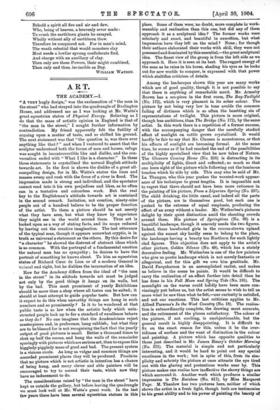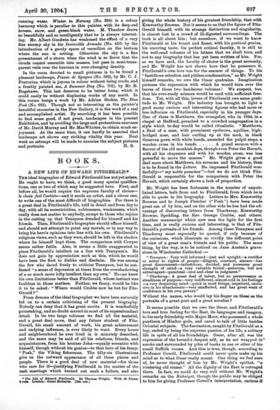House, and addressed me as I was looking at Mr.
Watts's great equestrian statue of Physical Energy. Believing as I do that the mass of artistic opinion in England is that of "the man in the street," I sought further information by contradiction. My friend apparently felt the futility of arguing upon a matter of taste, and so shifted his ground. The next statement was that "the question is, was there ever anything like that ? " and when I ventured to assert that the sculptor understood both the forms of men and horses, refuge was sought in incontrovertible like and dislike, and the con- versation ended with "What I like is a character." In these three statements is crystallised the normal English attitude towards art. In the first is shown the dislike of a great all- compelling design, for in Mr. Watts's statue the lines and masses sweep and rush with the force of a river in flood. The impression made is strong and individual, and the spectator cannot read into it his own prejudices and likes, as he often can in a tentative and colourless work. But the real key to the Englishman's attitude towards art is contained in the second remark. Imitation, not creation, ninety-nine people out of a hundred believe to be the proper function of the artist. To them a picture should be not merely what they have seen, but what they know by experience they might see in the world around them. Thus art is looked upon as a way of stating facts, and its scope reduced by leaving out the creative imagination. The last utterance of the typical man, though it appears somewhat cryptic, is in truth as universal a statement as the others. By this desire for "a character" he showed the distrust of abstract ideas which is so common. With the portrayal of a fundamental emotion the natural man has no sympathy ; he desires to have the portrait of something he knows about. To him an equestrian statue of Richard Coeur de Lion or of a modern General is natural and right, but he dislikes the incarnation of an idea.
How far the Academy differs from the ideal of "the man in the street" in its attitude towards art must be judged not only by the good things it hangs on its walls, but by the bad. This most prominent of yearly Exhibitions should be more than a shop where all tastes can be suited; it should at least attempt to guide popular taste. But how can it expect to do this when unworthy things are hung in such numbers and so prominently ? Is it to be wondered at that public taste is so low when the artistic body which unin- structed people look up to for a standard of excellence behave as they do P No one imagines that the Academicians reject masterpieces and, in preference, hang rubbish; but what they are to be blamed for is not recognising the fact that the yearly output of good pictures is small. Better a thousand times to shut up half the rooms, and hang the walls of the remainder sparingly with pictures which are serious art, than to expose this higgledy-piggledy mass of good and bad. The present system is a vicious circle. As long as vulgar and common things are accorded prominent places they will be produced. Proclaim that no picture which is not artistic in intention has a chance of being hung, and many clever and able painters will be encouraged to try to amend their taste, which now they have no inducement to do.
The considerations raised by "the man in the street" have kept us outside the gallery, but before leaving the quadrangle we must look well at Mr. Watts's great work. In the last few years there have been several equestrian statues in this
place. Some of them were, no doubt, more complete in work- manship and realisation than this one, but did any of them approach it as a sculptural idea ? The former works were scholarly and exact, and beautiful in execution, but what impression have they left on the mind ? None ; for though their authors elaborated their works with skill, they were not possessed and dominated by this essential,—the great sculptural idea. The finest view of the group is from the left side as we approach it. Here it is seen at its best. The rugged energy of the man as he reins in his horse, shading his eyes as he looks out for new worlds to conquer, is expressed with that power which stultifies criticism of details.
Among the landscapes shown this year are many works which are of good quality, though it is not possible to say that there is anything of remarkable merit. Mr. Arnesby Brown has a sea-piece in the first room, The Bay-Twilight (No. 172), which is very pleasant in its sober colour. The picture by not being very low in tone avoids the common failing of dirtiness which is so often the besetting sin of representations of twilight. This picture is more original, though less ambitious, than The Bridge (No. 172), by the same artist. In this work there is a repetition of a former success, with the accompanying danger that the carefully studied effect of sunlight on cattle grows crystallised. It would hardly be fair to say that Mr. Clausen is monotonous, or that his effects of sunlight are becoming formal. At the same time, he seems as if he had reached the end of the possibilities of the highly specialised view that he now takes of Nature. The Gleaners Coining Home (No. 258) is distracting in its multiplicity of lights, direct and reflected ; so much so that one loses sight of the picture while following out the luminous touches which lie side by side. This may also be said of Mr. La Thangue, who this year pushes the worsted-work appear- ance of his technique to great lengths. It is impossible not to regret that there should not have been more reticence in the painting of his picture, From a Ligurian Spring (No. 297). The child drinking, the little canal, and indeed all the parts of the picture, are in themselves good, but each one is pushed to the extreme of equal emphasis, producing the effect of an army without a leader. Mr. Wetherbee's pictures delight by their quiet distinction amid the shouting crowds around them. His picture of Springtime (No. 88) is a beautiful landscape, though it scarcely needs the two figures. Indeed, these barefooted girls in the crocus-strewn upland against the sunset sky hardly seem to belong to the place, the landscape having a beauty too Northern for such lightly clad figures. This objection does not apply to the artist's other picture, Golden Silence (No. 49), which has a stately decorative feeling. Mr. Wetherbee is one of the few painters who give us poetic landscape which is not merely fantastic or allegorical, and for this gift we owe him gratitude. Mr. David Farquharson is an accomplished realist, and makes us believe in the scene he paints. It would be difficult to carry the realisation of an effect further into detail than he has done in his Full Moon and Spring Tide (No. 195). The moonlight on the waves could ha1.dly have been more con- vincingly nut before us, but the artist seems to wish to tell us more what he saw than what he felt,—our curiosity is satisfied, and not our emotions. This last criticism applies to Mr. Alfred Parsons's In the West Country (No. 18). The realisa- tion is extraordinarily complete, the drawing most accurate, and the retirement of the planes satisfactory. The colour of the picture, if not exciting, is unobjectionable, but the general result is highly disappointing. It is difficult to fix on the exact reason for this, unless it be the over- tidiness of surface and the want of distinction in the colour and painting. A picture which has opposite qualities to those just described is Mr. James Henry's October Morning (No. 375). The material is simple and not particularly interesting, and it would be hard to point out any special excellence in the work ; but in spite of this, from its sim- plicity and sobriety the picture at once attracts the eye tired out with the glaring and pretentious works near by. This picture makes one realise how ineffective the showy things are which surround it. Another work which produces a similar impression is The Rainbow (No. 617), by Miss Margaret Page. M. Thaulow has two pictures here, neither of which shows the artist in a fresh light, though both are testimonies to his great ability and to his power of painting the beauty of
running water. Winter in Norway (No. 394) is a colour harmony which is peculiar to this painter, with its deep-red houses, snow, and green-black water. M. Thanlow draws so beautifully and so intelligently that be is always interest- ing. Mr. Albert Goodwin has weakened the effect of a very fine stormy sky in his Invincible Armada (No. 410) by the introduction of a gaudy space of vermilion on the horizon where the sun is setting. Otherwise the sky is a fine presentment of a storm when the wind is so fierce that the clouds cannot assemble into masses, but pass in semi-trans- parent veils over the heavens in ever-changing density.
In the room devoted to small pictures is to be found a pleasant landscape, Piazza di Spagna (No. 582), by Mr. C. J. Prmtorius, which is joyous in colour without being crude, and a freshly painted sea, A Summer Day (No. 702), by Mr. R. Bagshawe. This last deserves to be better hung, which it could easily be without displacing works of any merit. In this rooms hangs a work by Mr. Adrian Stokes, The Blue Pool (No. 682). Though not so interesting as the painter's beautiful moonrise in the New Gallery, it is the work of a real and accomplished artist. By searching it has been possible to find some good, if not great, landscapes in the present Exhibition, and by avoiding the large and pretentious canvases of Mr. David Murray and Mr. MacWhirter, to obtain much en- joyment. At the same time, it can hardly be asserted that landscape art shows any striking vitality this year. Next week an attempt will be made to examine the subject pictures and portraits. H. S.























































 Previous page
Previous page